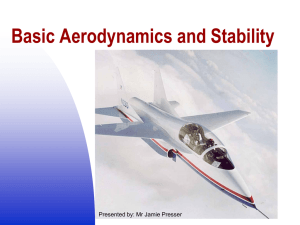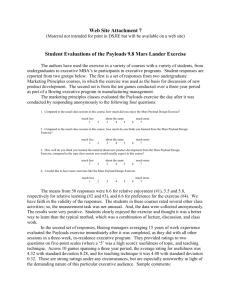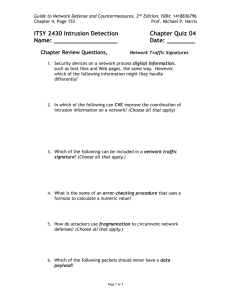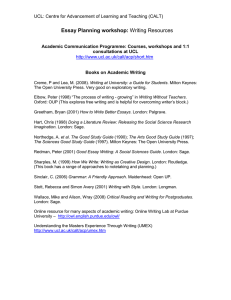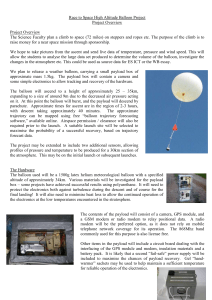CHAPTER 6 ENVIRONMENTAL CONDITIONS
advertisement
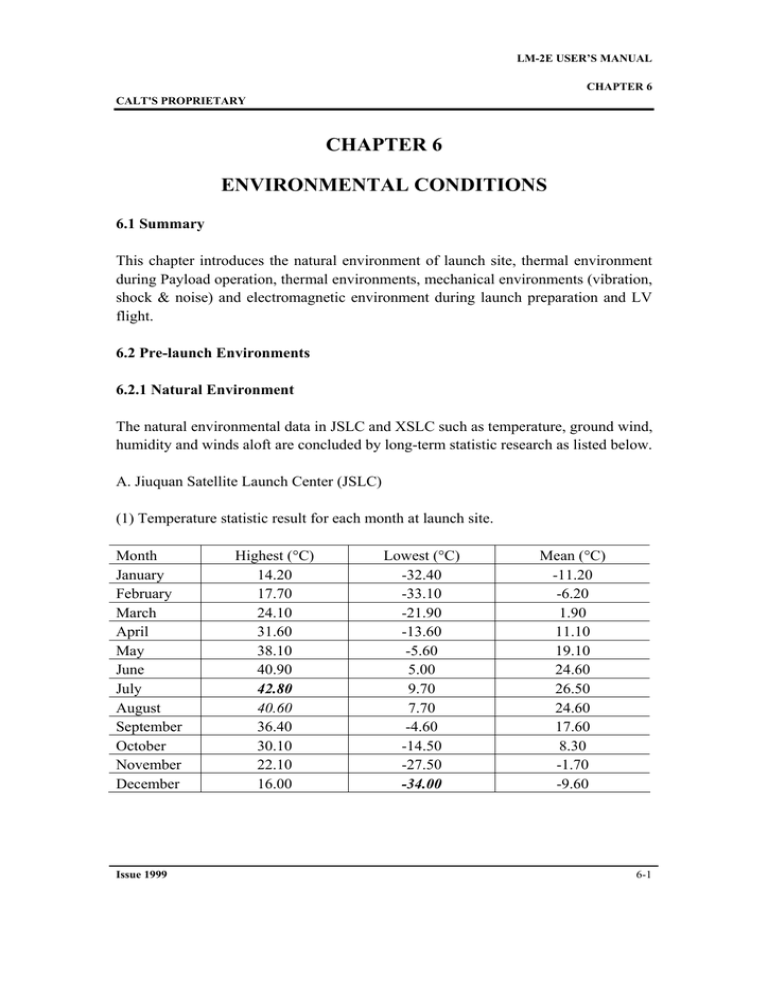
LM-2E USER’S MANUAL CHAPTER 6 CALT'S PROPRIETARY CHAPTER 6 ENVIRONMENTAL CONDITIONS 6.1 Summary This chapter introduces the natural environment of launch site, thermal environment during Payload operation, thermal environments, mechanical environments (vibration, shock & noise) and electromagnetic environment during launch preparation and LV flight. 6.2 Pre-launch Environments 6.2.1 Natural Environment The natural environmental data in JSLC and XSLC such as temperature, ground wind, humidity and winds aloft are concluded by long-term statistic research as listed below. A. Jiuquan Satellite Launch Center (JSLC) (1) Temperature statistic result for each month at launch site. Month January February March April May June July August September October November December Issue 1999 Highest (°C) 14.20 17.70 24.10 31.60 38.10 40.90 42.80 40.60 36.40 30.10 22.10 16.00 Lowest (°C) -32.40 -33.10 -21.90 -13.60 -5.60 5.00 9.70 7.70 -4.60 -14.50 -27.50 -34.00 Mean (°C) -11.20 -6.20 1.90 11.10 19.10 24.60 26.50 24.60 17.60 8.30 -1.70 -9.60 6-1 LM-2E USER’S MANUAL CHAPTER 6 CALT'S PROPRIETARY (2) The relative humidity at launch site is 35~55%. The dry season is all over the year, the average annual rainfall is 44mm. (3) The winds aloft used for LV design is an integrated vector profile, see Figure 6-1. (TO BE ISSUED) Figure 6-1 Wind Aloft Statistics Results in Jiuquan Area (TO BE ISSUED) B. Xichang Satellite Launch Center (1) Temperature statistic result for each month at launch site. Month January February March April May June July August September October November December Issue 1999 Highest (°C) 7.9 10.4 14.5 17.5 20.2 21.1 21.3 21.3 19.3 16.4 12.3 8.9 Lowest (°C) 4.5 5.0 9.7 13.1 15.6 17.7 19.3 18.5 16.2 13.2 8.4 4.6 Mean (°C) 5.9 8.0 11.7 15.0 17.7 19.1 20.0 19.8 17.2 14.1 10.0 6.5 6-2 LM-2E USER’S MANUAL CHAPTER 6 CALT'S PROPRIETARY (2) The relative humidity at launch site: Maximum: 100% at rain season; Minimum: 6% at dry season. (3) The winds aloft used for LV design is an integrated vector profile, see Figure 6-2, where the altitude is relative to the sea level. The local height above the sea level is 1800 m. Altitude(km) Altitude(km) 25 25 20 20 North Max. Wind Envelope 15 15 10 10 Condition Minimum Wind 5 5 0 0 0 20 40 60 Wind Speed (m/s) 80 100 200 300 250 Wind Direction ( o ) 350 Figure 6-2 Wind Aloft Statistics Results in Xichang Area Issue 1999 6-3 LM-2E USER’S MANUAL CHAPTER 6 CALT'S PROPRIETARY 6.2.2 Payload Processing Environment A. Payload Processing Environment in JSLC In JSLC, the environment impacting Payload includes 6 phases: (1) Processing in BS2; (2) transportation from BS2 to BS3; (3) Processing in BS3; (4) Transportation from BS3 to BLS; (5) Processing in BLS; (6) Transportation from BLS to the Umbilical Tower. B. Payload Processing Environment in XSLC In XSLC, Payload will be checked, tested in Payload Processing Buildings (BS2 and BS3) and then transported to the launch pad for launch. The environment impacting Payload includes 3 phases: (1) Processing in BS2 and BS3; (2) Transportation from BS3 to launch pad; (3) preparation on launch tower. Refer to Chapter 7. 6.2.2.1 Environment of Payload in BS2 The environmental parameters in BS2 and BS3, either at JSLC or XSLC, are as follows: Temperature: 15°C~25°C Relative humidity: 33%~55% Cleanliness: 100,000 level 6.2.2.2 Environment of Payload during Transportation to Umbilical Tower A. In JSLC The environment for Payload during transportation can be assured by temperature-control measures and/or selecting transportation time (e.g. in morning). B. In XSLC Before transportation to launch pad, the Payload will be put into the fairing in BS3 and then loaded onto the transfer vehicle. The transfer vehicle at XSLC equipped with Air-conditioning system which can keep the environment as that in BS3. It will take 30 minutes from BS3 to launch pad and 40 Issue 1999 6-4 LM-2E USER’S MANUAL CHAPTER 6 CALT'S PROPRIETARY minutes to mate to the second stage of Launch Vehicle. The Air Conditioning system will be cut off during the mating. Refer to Chapter 7 and Chapter 8. 6.2.2.3 Air-conditioning inside Fairing at Launch Pad The fairing air-conditioning system is shown in Figure 6-3. The air-conditioning parameters inside the fairing are as follows: Temperature: Relative Humidity: Cleanliness: Air Speed inside Fairing: Noise inside Fairing: Max. Air Flow Rate: 15°C~25°C 33%~55% 100,000 level ≤2m/s ≤90dB 3000~4000m3/hour The air-conditioning is shut off at L-45 minutes and would be recovered in 40 minutes if the launch aborted. Fairing Air Conditioning Control Air Flow Inlet (1) Measuring & Control Air Flow Inlet (2) Sensor Measuring: - Flow Velocity - Temperature - Humidity Exhaust Vents for Air Flow Access Door Figure 6-3 Fairing Air-conditioning on the Launch Tower Issue 1999 6-5 LM-2E USER’S MANUAL CHAPTER 6 CALT'S PROPRIETARY 6.2.3 Electromagnetic Environment 6.2.3.1 Radio Equipment onboard LM-2E and Ground Test Equipment Characteristics of on-board radio equipment and ground test equipment are shown below: EQUIPMENT L A U N C H V E H I C L E G R O U N D FREQUENCY (MHz) 2200~2300 POWER (W) 10 Telemetry Transmitter 2 2200~2300 10 Transponder 1 Rec.5860~5910 Tra.4210~4250 2 Telemetry Transmitter 1 Transponder 2 Rec.5580~5620 Tra.5580~5620 Beacon Telemetry command Receiver 2730~2770 550~750 Tester for Transponder 1 Tester for Transponder 2 Tester for Transponder 3 Telemetry Command Transmitter 5840~5890 0.5 5870~5910 0.5 5570~5620 100W(peak) 550~750 1W Issue 1999 300(max) 0.8~1.0µs 800Hz Pav<300 mW 2 susceptibility Polarization linear linear ≤-120dBW (14.77dBuv/m) linear ≤-90dBW (44.77dBuv/m) linear ≤-128dBW (4.77dBuv/m) linear linear Antenna position Stage-1 Inter-tank section Stage-2 Inter-tank section Stage -2 Inter-tank section Stage -2 Inter-tank section VEB Stage-2 Inter-tank section Tracking & safety system ground test room at launch center 6-6 LM-2E USER’S MANUAL CHAPTER 6 CALT'S PROPRIETARY 6.2.3.2 RF Equipment and Radiation Strength at XSLC and JSLC Working frequency Antenna diameter Impulse power Impulse width Min. pulse duration Mean power XSLC 5577~5617 MHz 4.2m <1500 kW 0.0008ms 1.25ms <1.2kW JSLC TBD TBD TBD TBD TBD TBD 6.2.3.3 LV Electromagnetic Radiation and Susceptibility The energy levels of launch vehicle electromagnetic radiation and susceptibility are measured at 1m above VEB. They are shown in Figure 6-4 to Figure 6-6. 6.2.3.4 EMC Analysis among Payload, LV and Launch Site To conduct the EMC analysis among Payload, LV and launch site, both Payload and LV sides should provide related information to each other. The information provided by CALT are indicated in the figures in this chapter, while the information provided by SC side are as follows: a. Payload RF system configuration, characteristics, working period, antenna position and direction, etc. b. Values and curves of the narrow-band electric field of intentional and parasitic radiation generated by Payload RF system at Payload/LV separation plane and values and curves of the electromagnetic susceptibility accepted by Payload. CALT will perform the preliminary EMC analysis based on the information provided by SC side, and both sides will determine whether it is necessary to request further information according to the analysis result. 6.2.4 Contamination Control The molecule deposition on Payload surface is less than 2mg/m2/week. The total mass loss is less than 1%. The volatile of condensable material is less than 0.1%. Issue 1999 6-7 LM-2E USER’S MANUAL CHAPTER 6 CALT'S PROPRIETARY Field Strength (dBuV/m) 150 140 130 120 110 100 90 80 70 60 50 40 30 20 10 0 2.2-2.3 GHz 135 dB 2.75-2.8 GHz 124 dB 5.2-5.7 GHz 130 dB 10 100 1000 10000 Frequency (MHz) Frequency (MHz) 2255.5 - 2265.5 2273.5 - 2283.5 2750 - 2760 5308 - 5333 5388 - 5408 5566 - 5626 5725 - 5750 5805 - 5825 Field Strength (dBµV/m) 134 130 126 120 120 134 100 100 Figure 6-4a Intentional Radiation from LM-2E and Launch Site (In JSLC) Issue 1999 6-8 LM-2E USER’S MANUAL CHAPTER 6 CALT'S PROPRIETARY Field Strength (dBuV/m) 150 140 130 120 110 100 90 80 70 60 50 40 30 20 10 0 0.01 0.1 1 10 100 1000 10000 Frequency (MHz) Frequency (MHz) 0.01-0.05 0.05-3 3-300 300-550 550-750 750-2200 2200-2300 2300-2730 2730-2770 2770-4200 4200-4250 4250-5580 5580-5620 5620-6000 6000-6500 6500-13500 13500-15000 15000- Field Strength (dBµV/m) 80 90 70 80 103 80 134 80 107 80 107 80 99 80 48 80 42 80 Figure 6-4b Intentional Radiation from LM-2E and Launch Site (In XSLC) Issue 1999 6-9 LM-2E USER’S MANUAL CHAPTER 6 CALT'S PROPRIETARY dBpT 100 90 80 70 60 50 0.01 0.1 1 10 100 1000 10000 kHz Figure 6-5a Magnetic Field Radiation from LV and Launch Site (In JSLC) Issue 1999 6-10 LM-2E USER’S MANUAL CHAPTER 6 CALT'S PROPRIETARY Field Strength (dBpT) 120 115 110 105 100 95 90 85 80 75 70 65 60 55 50 30 300 3000 30000 Frequency (MHz) Frequency (MHz) 30-150 150-300 300-50000 Field Strength (dBpT) 100-91 (linear) 91-65 (linear) 65 Figure 6-5b Magnetic Field Radiation from LV and Launch Site (In XSLC) Issue 1999 6-11 LM-2E USER’S MANUAL CHAPTER 6 CALT'S PROPRIETARY Field Strength (dBuV/m) 150 140 130 120 110 100 90 80 70 60 50 40 30 20 10 0 5.5-5.9 GHz 19 dB 600-700 MHz 3 dB 10 100 1000 10000 Frequenc y (MHz) Figure 6-6a LV Electromagnetic Radiation Susceptibility (In JSLC) Issue 1999 6-12 LM-2E USER’S MANUAL CHAPTER 6 CALT'S PROPRIETARY Field strength (dBuV/m) 150 140 130 120 110 100 90 80 70 60 50 40 30 20 10 0 0.01 0.1 1 10 100 1000 10000 Frequency (MHz) Frequency (MHz) 0.01-550 550-760 5580-5910 Field Strength (dBµV/m) 134 15 35 Figure 6-6b LV Electromagnetic Radiation Susceptibility (In XSLC) Issue 1999 6-13 LM-2E USER’S MANUAL CHAPTER 6 CALT'S PROPRIETARY 6.3 Flight Environment The mechanical environment for payload is at Payload/LV interface. The pressure environment and thermal environment is just for typical fairing. 6.3.1 Pressure Environment When the launch vehicle flies in the atmosphere, the fairing air-depressurization is provided by 12 vents (total venting area 230cm2) opened on the lower cylindrical section. The typical design range of fairing internal pressure is presented in Figure 6-7a and Figure 6-7b. The maximum depressurization rate inside fairing will not exceed 6.9 kPa/sec. 100 KPa 80 60 Upper Limit 40 Lower Limit 20 0 0 10 20 30 40 50 60 70 80 90 100 TIME(sec) Figure 6-7a Fairing Internal Pressure vs. Flight Time (from JSLC) Issue 1999 6-14 LM-2E USER’S MANUAL CHAPTER 6 CALT'S PROPRIETARY 100 KPa 80 60 Upper Limit 40 Lower Limit 20 0 0 10 20 30 40 50 60 70 80 90 100 TIME(sec) Figure 6-7b Fairing Internal Pressure vs. Flight Time (from XSLC) 6.3.2 Thermal environment The radiation heat flux density and radiant rate from the inner surface of the fairing is shown in Figure 6-8. The free molecular heating flux at fairing jettisoning shall be lower than 1135W/m2 (See Figure 6-9). After fairing jettisoning, the thermal effects caused by the sun radiation, Earth infrared radiation and albedo will also be considered. The specific affects will be determined through the Payload/LV thermal coupling analysis by CALT. Issue 1999 6-15 LM-2E USER’S MANUAL CHAPTER 6 CALT'S PROPRIETARY Q(W/m2) 500 450 A B εA= 0.4 εB= 0.4 εC= 0.17 εD= 0.17 400 C 350 D 300 A B 250 D 200 150 C 100 50 0 0 20 40 60 80 100 120 140 160 180 200 TIME(sec.) Figure 6-8 Radiation Heat Flux Density and Radiant Rate on the Inner Surface of Each Section of the Fairing Q (W/m2) 1000 800 600 400 200 0 0 200 400 600 800 1000 1200 1400 1600 TIME(sec) Figure 6-9 Typical Free Molecular Heating Flux Issue 1999 6-16 LM-2E USER’S MANUAL CHAPTER 6 CALT'S PROPRIETARY 6.3.3 Static Acceleration The maximum longitudinal acceleration during LV flight will not exceed 5.6g. The maximum lateral acceleration will not exceed 0.4g. 6.3.4 Vibration Environment A. Sinusoidal Vibration The sinusoidal vibration mainly occurs in the processes of engine ignition and shut-off, transonic flight and stage separations. The sinusoidal vibration (zero-peak value) at Payload/LV interface is shown below. Direction Longitudinal Lateral Frequency Range (Hz) 5 - 10 10 - 100 2-5 5 - 10 10 - 100 Amplitude or Acceleration 2.5 mm 1.0g 0.2g 2.0 mm 0.8 g B. Random Vibration The Payload random vibration is mainly generated by noise and reaches the maximum at the lift-off and transonic flight periods. The random vibration Power Spectral Density and the total Root-Mean-Square (RMS) value at Payload/LV separation plane in three directions are given in the table below. Frequency Range (Hz) 20 - 150 150 - 800 800 - 2000 Power Spectral Density +3dB/octave. 2 0.04 g /Hz -3 dB/octave. Total RMS Value 7.63 g 6.3.5 Acoustic Noise The flight noise mainly includes the engine noise and aerodynamic noise. The maximum acoustic noise Payload suffers occurs at the moment of lift-off and during the transonic flight phase. The values in the table below are the maximum noise levels in fairing. Issue 1999 6-17 LM-2E USER’S MANUAL CHAPTER 6 CALT'S PROPRIETARY Central Frequency of Octave Bandwidth (Hz) 31.5 63 125 250 500 1000 2000 4000 8000 Total Acoustic Pressure Level -5 0 dB referenced to 2×10 Pa. Acoustic Pressure Level (dB) 122 128 134 139 135 130 125 120 116 142 6.3.6 Shock Environment The maximum shock Payload suffers occurs at the Payload/LV separation. The shock response spectrum at Payload/LV separation plane is shown bellow. Frequency Range (Hz) 100-1500 1500-4000 Issue 1999 Response Acceleration (Q=10) +9.0 dB/octave. 4000 g 6-18 LM-2E USER’S MANUAL CHAPTER 6 CALT'S PROPRIETARY 6.4 Load Conditions for Payload Design 6.4.1 Frequency Requirement To avoid the Payload resonance with LM-2E launch vehicle, the primary frequency of Payload structure should meet the following requirement (under the condition that the Payload is rigidly mounted on the LV separation plane.): The frequency of the lateral main mode>8Hz The frequency of the longitudinal main mode >25Hz 6.4.2 Loads Applied for Payload Structure Design The maximum lateral load occurs at the transonic phase or Maximum Dynamic Pressure phase. The maximum axial static load occurs prior to the boosters’ separation. The maximum axial dynamic load occurs after the first and second stage separation. Therefore, the following limit loads corresponding to different conditions in flight are recommended for Payload design consideration. Flight Condition Longitudinal Static Acceleration(g) Dynamic Combined Lateral Combined Acceleration(g) Max. lateral load status +2.0 ±0.6 +2.6/+1.4 2.2 Max. Axial static load +5.6 ±0.6 +6.2/+5.0 1.0 Max. Axial dynamic load +0.8 ±2.0 +2.8/-1.2 2.0 Notes: n The loads are acting on the C.G of Payload. o The direction of the longitudinal loads is the same as the LV longitudinal axis. p The lateral load means the load acting in any direction perpendicular to the longitudinal axis. q Lateral and longitudinal loads occur simultaneously. r Usage of the above table: Payload design loads = Limit loads Safety factor* × * The safety factor is determined by the Payload designer.(What CALT suggests ≥1.25) Issue 1999 6-19 LM-2E USER’S MANUAL CHAPTER 6 CALT'S PROPRIETARY 6.4.3 Coupled Load Analysis The Payload manufacturer should provide the Payload mathematical model to CALT for Coupled Loads Analysis (CLA). CALT will predict the Payload maximum dynamic response by coupled load analysis. The Payload manufacturer should confirm that the Payload could survive from the predicted environment and has adequate safety margin. (CALT requires that the safety factor is equal to or greater than 1.25.) 6.5 Payload Qualification and Acceptance Test Specifications 6.5.1 Static Test (Qualification) The main Payload structure must pass static qualification tests without damage. The test level must be not lower than Payload design load required in Paragraph 6.4.2. 6.5.2 Vibration Test A. Sine Vibration Test During tests, the Payload must be rigidly mounted on the shaker. The table below specifies the vibration acceleration level (zero - peak) of Payload qualification and acceptance tests at Payload/LV interface. (See Figure 6-10 and Figure 6-11). Longitudinal Lateral Frequency (Hz) 5-10 8-100 2-5 5-10 10-100 Test Load Acceptance Qualification 2.5 mm 3.125 mm 1.0 g 1.25 g 0.25g 0.2 g 2.5mm 2.0mm 1.0 g 0.8 g 4 2 Scan rate (Oct/min) Notes: • Frequency tolerance is allowed to be ±2% • Amplitude tolerance is allowed to be ±10% • Acceleration notching is permitted after consultation with CALT and concurred by all parties. Anyway, the notched acceleration should not be lower than the coupled load analysis results on the interface plane. Issue 1999 6-20 LM-2E USER’S MANUAL CHAPTER 6 CALT'S PROPRIETARY • g Acceleration Qualification Level 1.0g 1 0.8g Acceptance Level 0.25g 0.2g 0.1 1 10 100 Hz Figure 6-10 Sinusoidal Vibration Test in lateral direction g Acceleration Qualification Level 1.25g 1 1.0g Acceptance Level 0.1 1 10 100 Hz Figure 6-11 Sinusoidal Vibration Test in axial direction Issue 1999 6-21 LM-2E USER’S MANUAL CHAPTER 6 CALT'S PROPRIETARY B. Random Vibration Test During tests, the Payload structure must be rigidly mounted onto the shaker. The table below specifies the Payload qualification and acceptance test levels at Payload/LV interface. (See Figure 6-12). Acceptance Spectrum Density Total rms (Grms) +3 dB/octave. 7.63g 0.04 g2/Hz -3 dB/octave. 1min. Frequency (Hz) Qualification Spectrum Density Total rms (Grms) +3 dB/octave. 10.79g 0.08 g2/Hz -3 dB/octave 2min. 20 - 150 150 - 800 800 - 2000 Duration Notes: • Tolerances of ±3.0 dB for power spectral density and ±1.5 dB for total rms values are allowed. • The random test can be replaced by acoustic test. g2/Hz 10-1 Qualification Level rms 10.79g rms acceleration 7.63g Acceptance Level -2 10 Hz 10-3 10 100 1000 10000 Figure 6-12 Random Vibration Test Issue 1999 6-22 LM-2E USER’S MANUAL CHAPTER 6 CALT'S PROPRIETARY 6.5.3 Acoustic Test The acceptance and qualification test levels are given in the following table (also see Figure 6-13). Central Octave Acceptance Sound Frequency (Hz) Pressure Level (dB) 31.5 122 63 128 125 134 250 139 500 135 1000 130 2000 125 4000 120 8000 116 Total Sound 142 Pressure Level -5 0 dB is equal to 2×10 Pa. Test Duration: 5 Acceptance test: 1.0 minute 5 Qualification test: 2.0 minutes Qualification Sound Pressure Level (dB) 126 132 138 143 139 134 129 124 120 146 Tolerance (dB) -2/+4 -1/+3 -4/+4 -4/+4 -1/+3 Sound Pressure Level (dB) 145 140 Qualification Level 135 130 146dB 125 142dB 120 Acceptance Level 115 110 10 100 1000 10000 Frequency (Hz) Figure 6-13 Payload Acoustic Test Issue 1999 6-23 LM-2E USER’S MANUAL CHAPTER 6 CALT'S PROPRIETARY 6.5.4 Shock Test The shock test level is specified in Paragraph 6.3.6. Such test shall be performed once for acceptance, and twice for qualification. A ±6.0 dB tolerance in test specification is allowed. However, the test strength must be applied so that in the shock response spectral analysis over 1/6 octave on the test results, 30% of the response acceleration values at central frequencies shall be greater than or equal to the values of test level. (See Figure 6-14) The shock test can also be performed through Payload/LV separation test by using of flight Payload, payload adapter, and separation system. Such test shall be performed once for acceptance, and twice for qualification. g Acceleration (Q=10) 4 10 4000g 1500Hz 3 10 2 10 1 10 10 1 2 10 Frequency Range (Hz) 100~1500 1500~4000 3 10 4 Hz 10 Shock Response Spectrum (Q=10) 9.0dB/octave 4000g Figure 6-14 Shock Response Spectrum at Payload/LV Separation Plane Issue 1999 6-24 LM-2E USER’S MANUAL CHAPTER 6 CALT'S PROPRIETARY 6.5.5 Proto-flight Test The Proto-flight test is suitable for the Payload that is launched by LM-2E for the first time even though it has been launched by other launch vehicles. The test level for the Proto-flight should be determined by satellite manufacturer and CALT and should be higher than the acceptance level but lower than the qualification level. If the same satellite has been tested in the conditions that are not lower than the qualification test level described in Paragraph 6.5.2 to Paragraph 6.5.4, CALT will suggest the following test conditions: a. Vibration and acoustic test should be performed according to the qualification level and acceptance test duration or scan rate specified in Paragraph 6.5.2-6.5.3. b. Shock test should be performed once according to the level in Paragraph 6.5.4. 6.6 Environment Parameters Measurement The flight environment is measured during each flight. The measured parameters include temperature and pressure, noises inside the fairing and the vibration parameters at Payload/LV interface. Issue 1999 6-25
